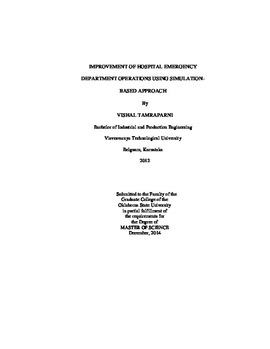| dc.contributor.advisor | Kamath, Manjunath | |
| dc.contributor.author | Tamraparni, Vishal | |
| dc.date.accessioned | 2016-01-20T15:45:05Z | |
| dc.date.available | 2016-01-20T15:45:05Z | |
| dc.date.issued | 2014-12-01 | |
| dc.identifier.uri | https://hdl.handle.net/11244/25724 | |
| dc.description.abstract | Scope and method of study: The study aimed at reducing the length of stay of patients in a hospital emergency department (ED) through systematic investigation using a simulation based approach. Literature review conducted during the course of study revealed a great amount of research conducted in understanding and improving the emergency department operations. Lately, ED has become the primary facility to obtain immediate healthcare services; hence, reducing patient's length of stay in ED has become a critical issue. The research developed a high fidelity simulation model that captures the major activities that occur during the course of treatment of patients at the Stillwater Medical Center ED. Data collection and analysis was carried out to generate inputs for the simulation model. Several alternate strategies such as an additional triage station to treat less emergent patients, additional doctor during peak hours and nursing staff dedicated to treating less emergent patients were developed which aided in reducing the waiting time of patients thereby reducing the length of stay. The strategies were analyzed and their performance was compared to that of the baseline simulation model.Findings and conclusions: A different approach of treating less emergent patients was developed by adding a triage station which increased the availability of rooms and reduced waiting time of patients before a room was assigned. Addition of a triage station dedicated to treating less emergent patients reduced patient's length of stay by 6.3%. With an additional doctor during peak hours it was observed that length of stay decreased by 13%. There was a decrease of almost 9% when a nurse was dedicated to fast-track patients. Instead of being dedicated, if the nurse had a priority for fast-track patients, the model showed a decrease in length of stay of 14%. Although the study was focused on the Stillwater Medical Center ED operations, the strategies developed during the research that could also be implemented in emergency departments that operate in a similar manner. Finally, this research has proposed a strategy that could be used to treat less emergent patients quickly and efficiently and thereby achieving overall reduction in the length of stay of patients. | |
| dc.format | application/pdf | |
| dc.language | en_US | |
| dc.publisher | Oklahoma State University | |
| dc.rights | Copyright is held by the author who has granted the Oklahoma State University Library the non-exclusive right to share this material in its institutional repository. Contact Digital Library Services at lib-dls@okstate.edu or 405-744-9161 for the permission policy on the use, reproduction or distribution of this material. | |
| dc.title | Improvement of Hospital Emergency Department Operations Using Simulation-based Approach | |
| dc.type | text | |
| dc.contributor.committeeMember | Heragu, Sunderesh | |
| dc.contributor.committeeMember | Liu, Tieming | |
| osu.filename | Tamraparni_okstate_0664M_13805.pdf | |
| osu.accesstype | Open Access | |
| dc.description.department | Industrial Engineering & Management | |
| dc.type.genre | Thesis | |
